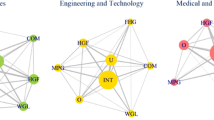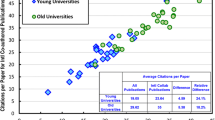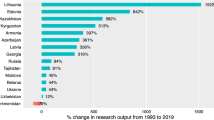Abstract
This study aims to investigate the influence of different patterns of collaboration on the citation impact of Harvard University’s publications. Those documents published by researchers affiliated with Harvard University in WoS from 2000–2009, constituted the population of the research which was counted for 124,937 records. Based on the results, only 12% of Harvard publications were single author publications. Different patterns of collaboration were investigated in different subject fields. In all 22 examined fields, the number of co-authored publications is much higher than single author publications. In fact, more than 60% of all publications in each field are multi-author publications. Also, the normalized citation per paper for co-authored publications is higher than that of single author publications in all fields. In addition, the largest number of publications in all 22 fields were also published through inter-institutional collaboration and were as a result of collaboration among domestic researchers and not international ones. In general, the results of the study showed that there was a significant positive correlation between the number of authors and the number of citations in Harvard publications. In addition, publications with more number of institutions have received more number of citations, whereas publications with more number of foreign collaborators were not much highly cited.




Similar content being viewed by others
Notes
See http://sciencewatch.com/about/met/journallist/ to find the list of ISI journals.
References
Abt, H. A. (2007). The frequencies of multinational papers in various sciences. Scientometrics, 72(1), 105–115.
Baldi, S. (1998). Normative versus social constructivist processes in the allocation of citations: a network-analytic model. American Sociological Review, 63, 829–846.
Beaver, D. B. (1986). Collaboration and teamwork in physics. Czechoslovak Journal of Physics, 36, 14–18.
Beaver, D. B. (2004). Does collaborative research have greater epistemic authority? Scientometrics, 60, 399–408.
Bordons, M., Garcia Jover, F., & Barrigon, S. (1993). Is collaboration improving research visibility? Research Evaluation, 3(1), 19–24.
Glänzel, W. (2001). National characteristics in international scientific co-authorship relations. Scientometrics, 51, 69–115.
Glänzel, W., & De Lange, C. (2002). A distributional approach to multinationality measures of international scientific collaboration. Scientometrics, 54, 75–89.
Katz, J. S., & Hicks, D. (1997). How much a collaboration worth? A calibrated bibliometric model. Scientometrics, 40, 541–554.
Katz, J. S., & Martin, B. R. (1997). What is research collaboration? Research Policy, 26(1), 1–18.
Lawani, S. M. (1986). Some bibliometric correlates of quality in scientific research. Scientometrics, 9, 13–25.
Luukkonen, T., Persson, O., & Sivertsen, G. (1992). Understanding patterns of international scientific collaboration. Science, Technology and Human Values, 17, 101–126.
Narin, F., & Whitlow, E. S. (1990). Measurement of scientific co-operation and co-authorship in CEC related areas of science. Report EUR 12900. Office for Official Publications in the European Communities, Luxembourg.
Narin, F., Stevens, K., & Whitlow, E. S. (1991). Scientific cooperation in Europe and the citation of multinationally authored papers. Scientometrics, 21(3), 313–323.
Patel, N. (1972). Collaboration in the professional growth of American Sociology. Social Science Information, 12(6), 77–92.
Schmoch, U., & Schubert, T. (2008). Are international co-publications an indicator for quality of scientific research? Scientometrics, 74(3), 361–377.
Schrage, M. (1995). No more teams: mastering the dynamics of creative collaboration. New York: Currency and Doubleday.
Sooryamoorthy, R. (2009). Do types of collaboration change citation? Collaboration and citation patterns of South African science publications. Scientometrics, 81(1), 177–193.
Van Raan, A. F. J. (1997). Science as an international enterprise. Science and Public Policy, 24(5), 290–300.
Wagner-Doebler, R. (2001). Continuity and discontinuity of collaboration behaviour since 1800 from a bibliometric point of view. Scientometrics, 52, 503–517.
Waltman, L., van Eck, N. J., van Leeuwen, T. N., Visser, M. S., & van Raan A. F. J. (2010). Towards a new crown indicator: an empirical analysis. http://arxiv.org/abs/1003.2167v2. Accessed 2 June 2010.
Author information
Authors and Affiliations
Corresponding author
Rights and permissions
About this article
Cite this article
Gazni, A., Didegah, F. Investigating different types of research collaboration and citation impact: a case study of Harvard University’s publications. Scientometrics 87, 251–265 (2011). https://doi.org/10.1007/s11192-011-0343-8
Received:
Published:
Issue Date:
DOI: https://doi.org/10.1007/s11192-011-0343-8




